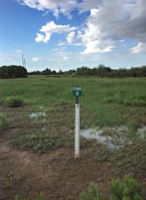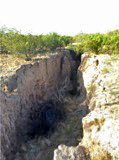Applying for the AHS Herman Bouwer Intern Scholarship was one of the best decisions I have ever made, and being selected as the 2015 recipient was one of the best things that has ever happened to me. I was ecstatic when I received notice that I had been selected. The three organizations I spent my summer interning with were the Town of Gilbert, ADWR, and Brown and Caldwell. My experience with each far exceeded my expectations. — Emily Montoya

The first 2 weeks of my internships were spent with the Town of Gilbert in its wastewater recharge department. Much of my time was spent doing field work, which included going to each recharge facility and reading the water depth measurements on the staff gauges in each basin, as well as reading flow meters on the pipes that feed the basins at each facility. There are three recharge facilities in Gilbert, and they occupy about 100 acres each. The southern most facility is the South recharge center and it has four basins. The northern most recharge site is the Neely recharge center and it has 11 basins with several of the basins housing solar panels that power the Neely wastewater treatment center. The third recharge center is the Riparian Preserve. It contains seven basins, each of which has a deep zone that is always filled with water so the natural wildlife can survive even when the rest of the basin is dry. The water that is sent to the basins at each recharge facility is treated wastewater. The ground at bottom of basins is disked and ripped to keep percolation rates high, and the water is then able to soak into the aquifer and recharge the groundwater supply.

I learned how to perform well sounding to measure the depth to water. The sounder water levels and readings taken at each recharge facility were conducted daily to ensure that the town had adequate and accurate data. One morning was spent learning how lake chemistry tests are completed. I also learned about Gilbert’s water conservation department, which performs landscape water audits on resident’s homes to help them conserve water. A significant loss of water is due to residents overwatering their landscaping because they are unaware of the proper amounts of water their plants actually need. In addition, I toured three water treatment plants.

The second agency I interned with was ADWR. The majority of my time was spent shadowing various people within the different divisions of the agency. I spent a day in Prescott learning how to replace transducers in wells, and I went to Tucson for a Safe Yield Task Force meeting. Tucson is trying to achieve safe yield by 2025, and this simply means that they want to recharge as much water into the ground as they are pumping out. It was very interesting to learn how they were planning to achieve this goal. I also shadowed people in the Groundwater Modeling Section where I learned how GIS programs are used to map wells throughout the state. The Colorado River Management Section was my favorite section in the department. I learned how Colorado River water is allocated and what happens to the water in the event of a shortage. I also spent time in the Floodplain Management Section, and learned about how Arizona manages floodplain regulations, as well as how rainfall is monitored through various rain gauges throughout the state by the Flood Warning Section.

ADWR is a large regulatory organization, and it was interesting to learn about the functions of their various divisions, and how they all operate together to make sure Arizona has an adequate water supply.
The third and final place I interned was Brown and Caldwell. Prior to my time with Brown and Caldwell, I was not entirely sure what consulting firms work on. However, after having the privilege of shadowing several engineers within the company, I have concluded that consulting is a possible career path that I would like to pursue. I was able to go to a preliminary design meeting where the company was presenting their design to the client. I was also able to sit in on a project proposal presentation where the company was presenting to a possible client about why they should be chosen to do the project. These meetings were both very educational because they gave me first-hand insight of how professional engineering meetings are conducted. The remediation department in the office was also of great interest to me. I talked with staff about groundwater and soil contamination due to leaking underground storage tanks, and I also learned about the permitting process for various forms of pollution that will be a result of projects. I enjoyed the fast pace environment at Brown and Caldwell as well as the variety of projects the engineers were working on.
Overall, this internship taught me more than I have learned in any of my classes. I was able to make connections between concepts that I have learned in school to various things that I observed during this internship. For example, when touring the water treatment plants during my time with the Town of Gilbert I was able to see the treatment process that I learned about in my classes actually being applied. However, I was also able to see aspects of the water industry business that I would have otherwise never been exposed to. At ADWR, I was able to learn how water in Arizona is managed, and at Brown and Caldwell I learned exactly how a professional engineering firm operates. This internship has made me even more passionate than I already was about environmental engineering, and it opened my eyes to many possible career paths I could take after graduating from college.
Lastly, I would like to thank the Town of Gilbert wastewater recharge department, ADWR, and Brown and Caldwell for allowing me to intern with them and lending insight into what they do. I would also like to thank AHS and its sponsors, who include a long-standing contribution from the CAP, for giving me this amazing opportunity.